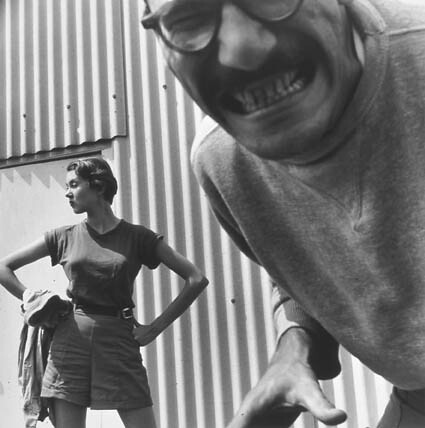Joel Oppenheimer & Francine Du Plessix Gray
at
(Photo by Jonathan Williams)
David Landrey sent the following letter after my note on Joel Oppenheimer last weekend. The
I am at once grateful for and guilt-ridden by the discussion of Joel Oppenheimer and his work: grateful that, 20 years after his death, there is renewed interest; guilt-ridden because I and some others who knew Joel in his later years (in my case through frequent visits to Buffalo, where, among many talks and readings, he delivered the 4th of the annual Charles Olson memorial lectures, following Duncan, McClure, and Sanders) have allowed those years to pass with relative silence.
As I point out (please excuse the self-promotion) in “Robert Creeley’s and Joel Oppenheimer’s Changing Visions” (in The World in Time and Space: Towards a History of Innovative American Poetry in our Time, Talisman House, 2001, 2002), Joel’s life and work changed utterly from 1970 on, as he stopped drinking and moved out into “New Spaces” (the title of perhaps his finest volume).
The comments so far in this thread—understandably, given the difficulty of acquiring his later work—are caught up in pre-1970. In fact: 1) his later work broke much new ground and grew stronger to the end; 2) his explorations of language and the worlds of politics and mind were huge and exciting; and 3) his poems were increasingly “supercharged with emotion,” and oh how they sing.
Kirby Olson asked if there are “any Oppenheimer poems that haunt the imaginations of any contemporary readers.” What folks on this line have not seen is Collected Later Poems, published in 1997 by The Poetry/Rare Books Collection of SUNY Buffalo, wherein there is a gold mine of such work. Start with “The Woman Poems” (1975) and read on. Some particularly extraordinary pieces are: “A Village Poem,” “Lessons I & II,” “Acts,” “Cacti,” “Houses,” “The Uses of Adversity” (such a powerful presentation of his chemotherapy as to cause some of my Turkish colleagues to quit smoking); and “New Hampshire Journal.” I’ve seen many friends re-read Collected Later Poems and become torn by emotion, yet his reputation lags.
His reputation’s bad fortune can be illustrated by a Sunday book-signing at St. Mark’s Church in the Village in 1997. Robert Bertholf and I had published a collection of his Village Voice essays called Drawing From Life (Asphodel Press), but the books we were to sign had been sent to St. Mark’s Bookstore instead of to the church. The store was closed.
References to Lyman Gilmore’s biography are right on. The book is a profoundly insightful study of the man and his work. (Lyman has also written a superb biography of William Bronk: The Force of Desire. Both biographies are published by Talisman House.)
For a fine sense of Joel in the late years, read Robert J. Bertholf’s Remembering Joel Oppenheimer, also from Talisman. And try to find: 1) The Wrong Season, 1973 from Bobbs-Merrill, an immersion in the 1972 Mets; 2) Poetry, the Ecology of the Soul, 1983 from White Pine, a selection of Talks and Poems.
I hope that this discussion produces the awareness of Joel’s work that it richly deserves.
David Landrey,






